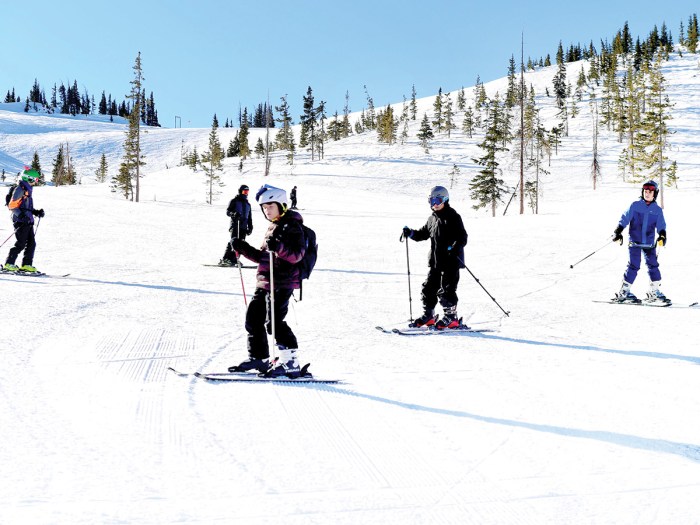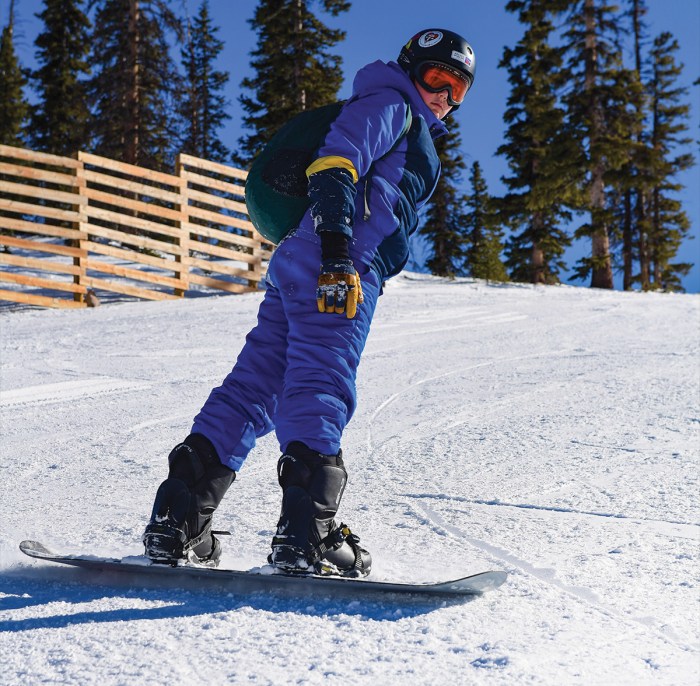Colorado Scouts Conquer Slopes on Ski Weekend

After spending 15 hours speeding down the slopes and rekindling his skiing skills, Nathan Kaley didn’t want his troop’s weekend ski trip to end. But the schedule and his body said otherwise.
“I wish school was off so we could go another day, but I was tired,” the 12-year-old First Class Scout says. “If tiredness did not exist, I’d go for five more days.”
Still, two days proved to be plenty of time to work on a merit badge, learn some techniques and create great memories.

NEW YEAR, NEW TRIP
Every year, Troop 1 of Colorado Springs, Colorado, goes skiing at Monarch Mountain. About a two-hour drive away for the guys, the ski resort in the Rocky Mountains of Colorado offers 63 runs at varying levels of difficulty. Although some of them had skied before, last January’s trip would be some Scouts’ first time, so everyone prepared the same.
Reading the Snow Sports merit badge pamphlet, they reviewed ski equipment, proper clothing and trail markers. Markers identify each ski slope with an assigned color: green for easy, blue for intermediate and black for difficult.

“We discussed it so you wouldn’t go down a steep hill,” says Paolo Madrid, 12, a First Class Scout. “Usually there’s a sign next to the run.”
After a couple weeks of planning, the guys headed to a lodge a few miles from the resort.

START OFF EASY
On the first day, everyone hopped on the bunny hill, a gentle incline for beginners.
“It’d been a long time since I had skied,” Nathan says. “A few others and I were seeing what our ski levels still were.”
The adult leaders assessed everyone’s abilities — some needed to stay on easy slopes, while others were ready for hard runs. All the Scouts took to the green-level slopes first before advancing to more challenging runs.

Everyone used the buddy system, so they paired up with a friend or two for all activities. If someone fell or lost a ski, someone would be there to help. On this trip, both happened frequently.
“That’s why we have the buddy system,” says First Class Scout Keegan Bench, 12.
If someone were to get hurt or lost, having a buddy could prevent a serious situation from becoming worse. The system helps ensure everyone’s safety.

MOVING UP
Keegan tried snowboarding instead of skiing. Generally, skiing is easier to learn, but as an experienced skier, Keegan wanted to try something new. And as with anything new, practice helps you get better — even on seemingly simple tasks like getting back up after you fall.
On a snowboard, you can get up by rolling over onto your stomach and pushing yourself up onto your hands and knees. This is called getting up “toeside.” Standing up from a seated position is called getting up “heelside.”
“I don’t know how people do it heelside,” Keegan says.

Again, it takes practice. To stand up that way, move your board close to your body and dig the back (heelside) edge of your board into the snow. Use your hands to push yourself up. Some people find grabbing the front (toeside) edge helps them keep their balance.
After eight hours on the slopes, the troop headed back to the lodge to clean up and eat dinner.
“We made a humble Scout meal of ramen,” Nathan says.

Downhill skiing can be strenuous; you can burn a couple hundred calories within a half-hour. Eating food rich in carbohydrates can help your body recover by replenishing your muscles’ glycogen, a type of sugar that provides your body with energy.
Paolo, who lost his ramen flavor packet, says, “I ate plain noodles; it was not fun. But noodles were good enough for me.”

LET’S GO AGAIN
Eating carbs before a workout maintains your energy. On the second day, the Scouts ate oatmeal and biscuits and gravy before tackling the mountain for seven hours.
“Everybody got on the more challenging stuff,” Nathan says. “It’s nice to feel that fast feeling while you’re going on an easy route. I did feel more comfortable with the slopes I liked, but I tried a few more blues.”
With added confidence from a day of skiing, Nathan and his buddy, Nehemiah Hurtado, advanced to the intermediate slopes. The knowledge from the Snow Sports merit badge also helped, especially in practicing turns and stops.

“I think it was beneficial since I liked the skiing so much,” says Nehemiah, 11.
“It’s a great idea to try the merit badge,” Keegan says. “It was a great addition to the trip.”
Mountain Tips
Try these tips shared from Troop 1 to help your ski trip go smoothly:
- Purchase your lift tickets and ski gear before going. You can usually find better deals this way; plus, you won’t have to wait in line at the resort.
- When you take a break, place your gloves inside your helmet so you don’t misplace them.
- Keep any loose items in zippered pockets so you don’t lose them while skiing.
- Carry a small backpack containing your outdoor Scout Essentials, including water. Stay hydrated; skiing can be a workout.

Showing Their Colors
Ski slopes are rated based on their steepness. A 45-degree angle equals a 100% grade.
Green circle: Easy. Slopes are groomed and wide. The slope grades are less than 25%.
Blue square: Intermediate. Slopes are groomed but steeper. Slope grades go from 25% to 40%.
Black diamond: Advanced. Slopes could be groomed or not. Grades are 40% or more.
Double black diamond: Expert. Narrow slopes can have drop-offs and obstacles like trees. Grades are 40% or more and often include backcountry routes.
I like how you showed a small set of tips for when you’re skiing. Especially purchasing your equipment and tickets early, since skiing can be rather expensive.